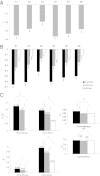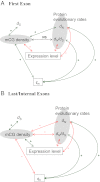Position-dependent correlations between DNA methylation and the evolutionary rates of mammalian coding exons
- PMID: 23019368
- PMCID: PMC3465446
- DOI: 10.1073/pnas.1208214109
Position-dependent correlations between DNA methylation and the evolutionary rates of mammalian coding exons
Abstract
DNA cytosine methylation is a central epigenetic marker that is usually mutagenic and may increase the level of sequence divergence. However, methylated genes have been reported to evolve more slowly than unmethylated genes. Hence, there is a controversy on whether DNA methylation is correlated with increased or decreased protein evolutionary rates. We hypothesize that this controversy has resulted from the differential correlations between DNA methylation and the evolutionary rates of coding exons in different genic positions. To test this hypothesis, we compare human-mouse and human-macaque exonic evolutionary rates against experimentally determined single-base resolution DNA methylation data derived from multiple human cell types. We show that DNA methylation is significantly related to within-gene variations in evolutionary rates. First, DNA methylation level is more strongly correlated with C-to-T mutations at CpG dinucleotides in the first coding exons than in the internal and last exons, although it is positively correlated with the synonymous substitution rate in all exon positions. Second, for the first exons, DNA methylation level is negatively correlated with exonic expression level, but positively correlated with both nonsynonymous substitution rate and the sample specificity of DNA methylation level. For the internal and last exons, however, we observe the opposite correlations. Our results imply that DNA methylation level is differentially correlated with the biological (and evolutionary) features of coding exons in different genic positions. The first exons appear more prone to the mutagenic effects, whereas the other exons are more influenced by the regulatory effects of DNA methylation.
Conflict of interest statement
The authors declare no conflict of interest.
Figures



Similar articles
-
The evolution of the coding exome of the Arabidopsis species--the influences of DNA methylation, relative exon position, and exon length.BMC Evol Biol. 2014 Jun 25;14:145. doi: 10.1186/1471-2148-14-145. BMC Evol Biol. 2014. PMID: 24965500 Free PMC article.
-
DNA methylation is associated with an increased level of conservation at nondegenerate nucleotides in mammals.Mol Biol Evol. 2014 Feb;31(2):387-96. doi: 10.1093/molbev/mst208. Epub 2013 Oct 24. Mol Biol Evol. 2014. PMID: 24157417 Free PMC article.
-
Impacts of pretranscriptional DNA methylation, transcriptional transcription factor, and posttranscriptional microRNA regulations on protein evolutionary rate.Genome Biol Evol. 2014 Jun 12;6(6):1530-41. doi: 10.1093/gbe/evu124. Genome Biol Evol. 2014. PMID: 24923326 Free PMC article.
-
Cross-species clues of an epigenetic imprinting regulatory code for the IGF2R gene.Cytogenet Genome Res. 2006;113(1-4):202-8. doi: 10.1159/000090833. Cytogenet Genome Res. 2006. PMID: 16575181 Review.
-
Reading the unique DNA methylation landscape of the brain: Non-CpG methylation, hydroxymethylation, and MeCP2.Proc Natl Acad Sci U S A. 2015 Jun 2;112(22):6800-6. doi: 10.1073/pnas.1411269112. Epub 2015 Mar 4. Proc Natl Acad Sci U S A. 2015. PMID: 25739960 Free PMC article. Review.
Cited by
-
Identification of DNA motifs that regulate DNA methylation.Nucleic Acids Res. 2019 Jul 26;47(13):6753-6768. doi: 10.1093/nar/gkz483. Nucleic Acids Res. 2019. PMID: 31334813 Free PMC article.
-
DNA methylation and evolution of duplicate genes.Proc Natl Acad Sci U S A. 2014 Apr 22;111(16):5932-7. doi: 10.1073/pnas.1321420111. Epub 2014 Apr 7. Proc Natl Acad Sci U S A. 2014. PMID: 24711408 Free PMC article.
-
Antagonistic and synergistic epigenetic modulation using orthologous CRISPR/dCas9-based modular system.Nucleic Acids Res. 2019 Oct 10;47(18):9637-9657. doi: 10.1093/nar/gkz709. Nucleic Acids Res. 2019. PMID: 31410472 Free PMC article.
-
Whole-genome fingerprint of the DNA methylome during chemically induced differentiation of the human AML cell line HL-60/S4.Biol Open. 2020 Feb 17;9(2):bio044222. doi: 10.1242/bio.044222. Biol Open. 2020. PMID: 31988093 Free PMC article.
-
The association between DNA methylation and exon expression in the Pacific oyster Crassostrea gigas.PLoS One. 2017 Sep 25;12(9):e0185224. doi: 10.1371/journal.pone.0185224. eCollection 2017. PLoS One. 2017. PMID: 28945769 Free PMC article.
References
-
- Reik W, Dean W, Walter J. Epigenetic reprogramming in mammalian development. Science. 2001;293:1089–1093. - PubMed
-
- Li E, Beard C, Jaenisch R. Role for DNA methylation in genomic imprinting. Nature. 1993;366:362–365. - PubMed
-
- Heard E, Clerc P, Avner P. X-chromosome inactivation in mammals. Annu Rev Genet. 1997;31:571–610. - PubMed
-
- Walsh CP, Chaillet JR, Bestor TH. Transcription of IAP endogenous retroviruses is constrained by cytosine methylation. Nat Genet. 1998;20:116–117. - PubMed
-
- Feinberg AP, Tycko B. The history of cancer epigenetics. Nat Rev Cancer. 2004;4:143–153. - PubMed
Publication types
MeSH terms
LinkOut - more resources
Full Text Sources

